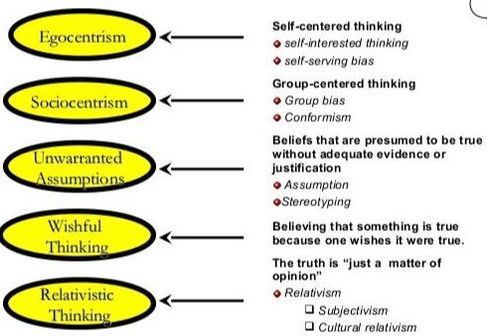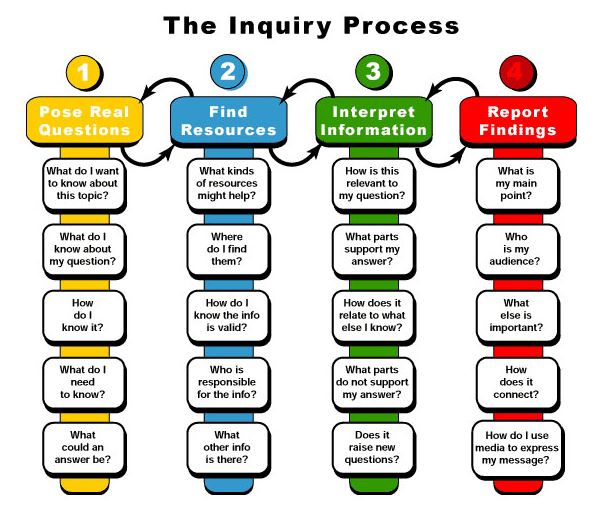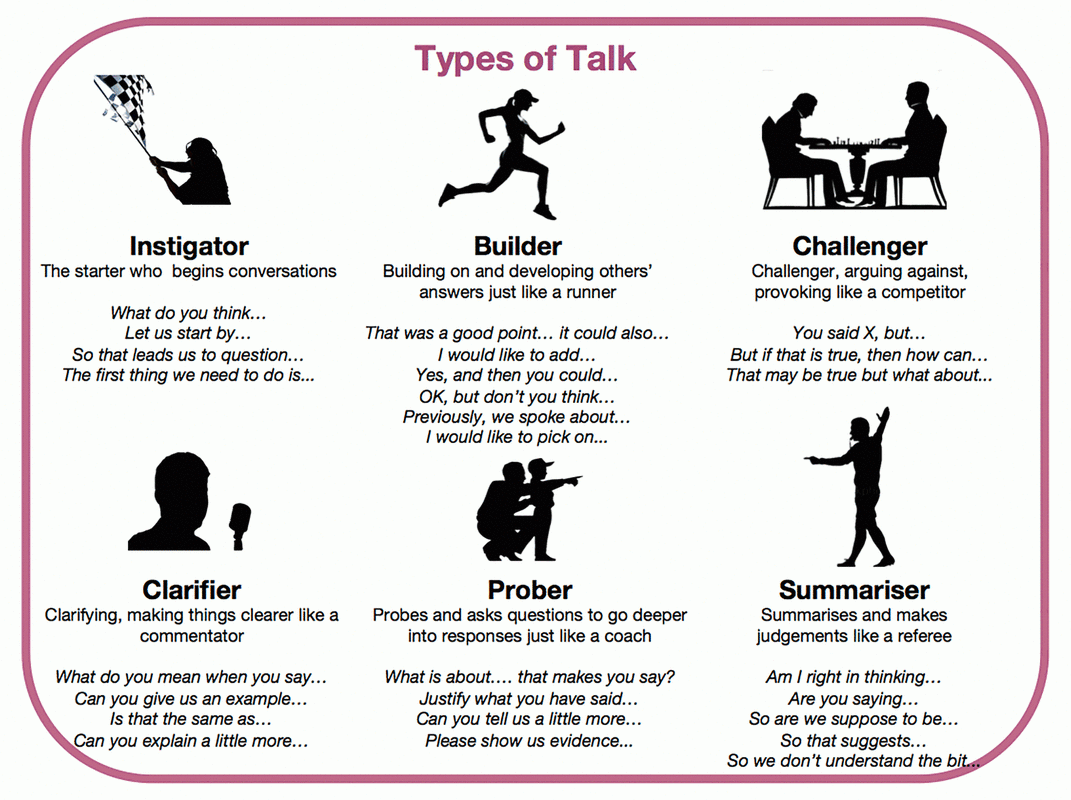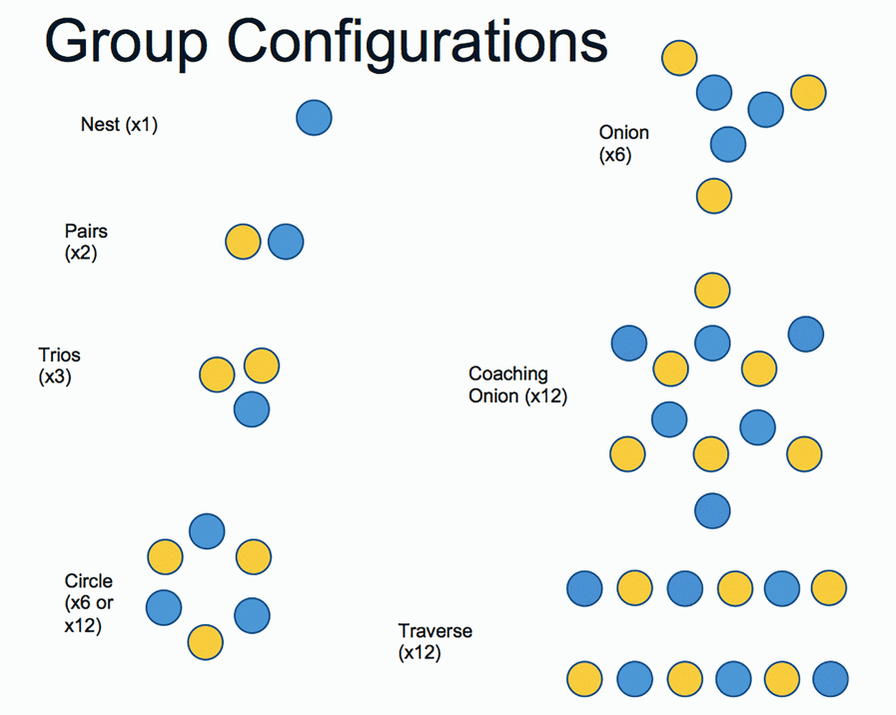Critical Thinking
Critical Thinking for Change
|
Effective, inclusive education "requires more than developing socio-political awareness, teaching skills and understanding how children learn and develop. Moving from theory to practice also requires the courage to create schools that look very different from those we have now (Kugelmass, 2000, p. 93). |
Critical thinking and inquiry are necessary for all stakeholders to be active participants in developing themselves, schools, communities and the world. Moving beyond tolerance to adapting and adopting critical thinking processes and diverse perceptions can help individuals independently and collectively solve a wider range of problems locally, nationally and internationally.
1. Critical Inquiry is the process of gathering and evaluating information, ideas, and assumptions from multiple perspectives to produce well-reasoned analysis and understanding, leading to new ideas, applications and questions. (University of South Carolina University, 2017)
2. Critical Thinking is an umbrella term for six core skills, all of which combine to allow you to work, think, and act more effectively and more strategically: (Van den Brink-Budgen, 2016)
1. Critical Inquiry is the process of gathering and evaluating information, ideas, and assumptions from multiple perspectives to produce well-reasoned analysis and understanding, leading to new ideas, applications and questions. (University of South Carolina University, 2017)
2. Critical Thinking is an umbrella term for six core skills, all of which combine to allow you to work, think, and act more effectively and more strategically: (Van den Brink-Budgen, 2016)
Teaching and learning in inclusive schools must be purposeful, relevant and relate to the lives of all stakeholders, especially students. Thus, critical thinking is a valuable tool in creating flexible, reflective thinkers who can actively participant in developing themselves, the communities and the world. Therefore, critical thinking skills need to be included in early years education and onward as well as embedded into the curricula and school culture. Unquestionably, schools have a responsibility to empower all students by providing inquiry-based learning to explore multiple viewpoints and problems in complex, rich, meaningful contexts.
Developing critical and inquiry thinking is essential, but there are may barriers to overcome: Source: Introduction to Critical Thinking (2011)
Providing all students with opportunities for deeper understanding is key in addressing barriers which prevent critical inquiry and thinking as well as promote inclusive practices. In the classroom, the curriculum should be co-constructed with students, so they can explore topics central to their lives and the community. In addition, students need to metacogitively describe critical thinking development. Thus, students who take more responsibility for their learning are more likely to embrace critical thinking processes and become more inclusive, culturally responsive and reflective citizens and learners. |
Note: 20 Questions to Guide Critical Inquiry. From: Educational Jargon Wikispace
Exploring learning through questioning, discussion and reflection
Students learn about literature and visual literacy by applying critical thinking skills. They read, search for meaning, ask questions, question relevancy, formulate arguments and defend their claims. They look for deeper meanings such as: What is the purpose of the text? What are the bigger issues within the text? How does this text apply to life? What is the author trying to tell us about life?
|
|
Critical Thinking Resources
Top Ten Books to Teach Point of View by Reading Power Gear (2016). Voices in the Park by Anthony Brown, The Teddy Bear by David McPhail, The Day the Crayons Quit by Drew Daywalk, The Seven Blind Mice by Ed Young, Hey, Little Ant by Phillip and Hannah Hoose, School's First Day of School by Adam Rex, They All Saw a Cat by Brendan Wenzel, I am the Dog, I am the Cat by Judy Blume, The Pain and the Great One by Chris Van Allburg, The Wolf's Story by Toby Forward and Izhar Cohen, The Very Smart Pea and the Princess-to-Be by Mini Grey Critical Thinking Apps for Extending Student Learning by Teacher Thought. Some apps include Information Network Analysis, Flight Pilot Simulator 3D, Civilization V, Assembly Design, Shakespeare in Bits, Literary Analysis Guide, SPEEDSim: Spatial Population Ecological and Epidemiological Dynamic Simulator, Animate Me, Opposing view, Artificial Life and more Beyond Question Stems: Critical Thinking in the 21st Century Classroom by Jennifer Jones. Excellent resource with many strategies for critical thinking in the classroom Cultivating Critical Thinking in the Classroom by Saima Abedi. Questions stems, setting goals and other critical thinking strategies Text Coding by PBWorks. Some text coding suggestions while reading. (can also have students construct their own) |
Critical Pedagogy For Inclusion and Justice
Critical Pedagogy, an educational theory (Friere, 1970), raises learners' awareness, challenges and transforms oppressive social conditions and inequalities by cultivating an understanding and acceptance of people regardless of their culture, gender, socio-economic status or sexual orientation(Simandan, 2011). This theory must connect to students' practical, lived experiences within and outside the classroom (Van Manen, 1999) and greater connectivity will enable students to transform their schools, communities and the world for social justice as well as provide a more inclusive society. Thus, schooling is more than providing critical thinking opportunities or a moral act, it is also a political intervention (Giroux, 2004). Therefore, culturally relevant classrooms are necessary to connect the home culture with the school culture and critical pedagogy transforms education system and community life .
Paulo Freire and Ira Shor develop praxis, connect theory to practice by evaluating and reflecting on actions. The learning process begins with generative content, a co-constructed curriculum with students and teachers. Then, students describe, interpret and analyze a problem related to their experience. Action plans are developed as the problem is solved and then students enact their plans and evaluate and reflect on the results. With the goal of transforming oppressive conditions and power relations, the transformative process requires students and teachers to acknowledge the existence of power relations in the classroom and society. In addition, culturally relevant classrooms must be pedagogically emphasized because it connects the home and school cultures (Brown, 20007). Thus, critical pedagogy in the classroom can create equally socially just, inclusive schools, education systems and communities (White, Cooper & Mackey, 2014).
Paulo Freire and Ira Shor develop praxis, connect theory to practice by evaluating and reflecting on actions. The learning process begins with generative content, a co-constructed curriculum with students and teachers. Then, students describe, interpret and analyze a problem related to their experience. Action plans are developed as the problem is solved and then students enact their plans and evaluate and reflect on the results. With the goal of transforming oppressive conditions and power relations, the transformative process requires students and teachers to acknowledge the existence of power relations in the classroom and society. In addition, culturally relevant classrooms must be pedagogically emphasized because it connects the home and school cultures (Brown, 20007). Thus, critical pedagogy in the classroom can create equally socially just, inclusive schools, education systems and communities (White, Cooper & Mackey, 2014).
|
Inclusion and Social Justice Resources
Resources to Support Inclusion by Shelley Moore. Includes a wide variety of resources to support all students. Resources are organized by curricular competencies, grade level, literacy activities and literacy level. Social Justice Begins with Me by the Elementary Teachers' Federation of Ontario. Resource kits and books lists for Early Years to Grade 8. Flower Power Lesson Plan by Wenh-In based on Doris Marshall Institute. Students explore and reflect on their identities. An Educator's Guide to Changing the World: Methods, Models and Materials for Anti-Oppression and Social Justice Workshops by Ann Curry-Stevens. A comprehensive resource with theory as well as practice resources for social justice. Discrimination and Stereotypes Lesson Plans by Advocates for Youth. Includes lessons as well as literary materials for Ages 13 and up. Critical Pedagogy: Rethink your Values by MrsScience601. A Youtube Video with some powerful questions about the purpose of education and life, created for students. Educational Equity Case Studies by Paul C. Gorski. Case studies on race, class, gender, gender identity and sexual orientation |
Critical Dialogue: Empowered Speakers
Developing dialogue around relevant issues is essential in enacting critical pedagogy for social justice and providing inclusive education. Notably, new knowledge in the classroom is grounded in student and teacher experiences, alike, through meaningful dialogue (Nikolakaki, 2012). This dialogue is critical in moving beyond the classroom by providing opportunities for individual and collective exploration as well as connecting to political action.
|
|
|
|
Tips for Dialogue in the Classroom
Tip #1 As a class, establish guidelines for communication.
Tip #2 Develop norms around visuals, acrostic poetry or other procedures to support better communication strategies (Ex. SLANTING- sit you, lean forward, act interested, nod occasionally, track the talk). Tip #3 Use a variety of flexible groups so students can communicate with a variety of people for different purposes. Tip #4 Support students using sentence stems. Sentence stems should be based on context to empower students to use language for audience and purpose. |
Note: Different purposes of talking by School 21
|
|
English
|
Art
|
Note: This shows different ways to do partner talk. The yellow and blue dots represent "pairs" of students by School 21
|
|
Oracy in the Classroom and Critical Content Resources
Debate.org is a free online community about relevant issues around the world.
Prism Toolkit for secondary schools and by Alberta Teachers' Association. It is for safe and caring discussions about sexual and gender minorities. Can download it directly from the site. Prism Toolkit for elementary schools and by Alberta Teachers' Association. It is for safe and caring discussions about sexual and gender minorities. Can download it directly from the site. |
Communicating for Restorative Justice
|
|
Restorative Justice for Conflicts
It focuses on needs of the victims, community and offenders. It stakeholders in the resolution process and focuses on responsibility, reasons, causes and feelings. It brings everyone together to discuss and dialogue and to minimize a negative re-occurrence. Ask: 1. Who has been affected and how? 2. How can we make it right? 3. What have we learned and how can we make different choices next time? |
|
|
Restorative Justice Practices: Community Classroom Talking Circles
|
REFERENCES
Brown, M.R. (2007). Educating all students: Creating culturally responsive teachers, classrooms, and schools. Intervention in School and Clinic, 43, 57-62.
Giroux, H.A. (2004). Critical pedagogy and the postmodern/modern divide: Towards a pedagogy of democratization. Teacher Education Quarterly, 31, 31-47.
Kugelmass, J. W. (2000). Subjective experience and the preparation of activist teachers: confronting the mean old snapping turtle and the great big bear. Teacher and Teaching Education: An International Journal of Research and Studies, 16, 179-194.
Nikolakaki, M. (2012). Building a society of solidarity through critical pedagogy: Group teaching as a social and democratic tool. Journal for Critical Education Policy Studies, 10, 392-417.
Simandan, V. (2011). A bird's eye view presentation of critical pedagogy. Journal Plus Education, 7, 246-250.
Van Manen, M. (1999). The language of pedagogy and the primacy of student experience. In J. Loughran (Ed.), Researching teaching: Methodologies and practices for understanding pedagogy (13-17). London. Falmer.
White R.E, Copper, K., & Mackey, W. (2014). Culturally relevant education and critical pedagogy: Devolution of hierarchies of power. International Journal for Social Justice, 3, 123-140.
Giroux, H.A. (2004). Critical pedagogy and the postmodern/modern divide: Towards a pedagogy of democratization. Teacher Education Quarterly, 31, 31-47.
Kugelmass, J. W. (2000). Subjective experience and the preparation of activist teachers: confronting the mean old snapping turtle and the great big bear. Teacher and Teaching Education: An International Journal of Research and Studies, 16, 179-194.
Nikolakaki, M. (2012). Building a society of solidarity through critical pedagogy: Group teaching as a social and democratic tool. Journal for Critical Education Policy Studies, 10, 392-417.
Simandan, V. (2011). A bird's eye view presentation of critical pedagogy. Journal Plus Education, 7, 246-250.
Van Manen, M. (1999). The language of pedagogy and the primacy of student experience. In J. Loughran (Ed.), Researching teaching: Methodologies and practices for understanding pedagogy (13-17). London. Falmer.
White R.E, Copper, K., & Mackey, W. (2014). Culturally relevant education and critical pedagogy: Devolution of hierarchies of power. International Journal for Social Justice, 3, 123-140.
© Copyright 2017 Inclusion Canada All rights reserved
Created, Designed, Developed and Written by L. Goolcharan
Created, Designed, Developed and Written by L. Goolcharan








